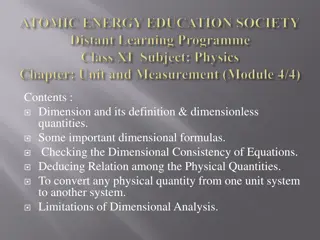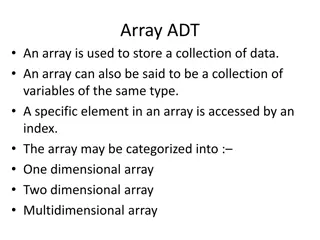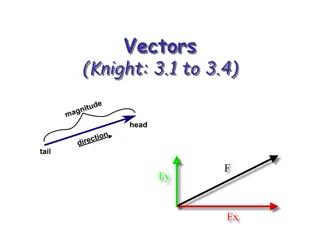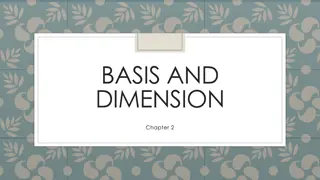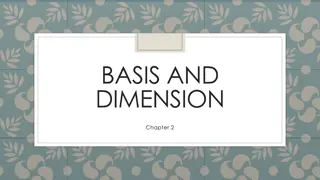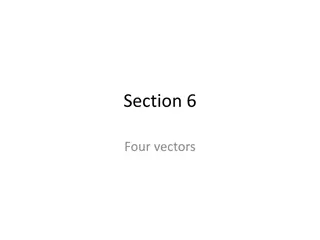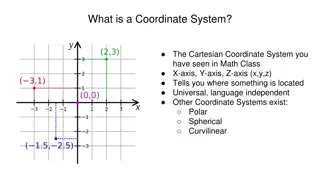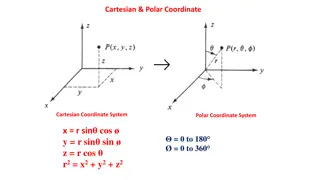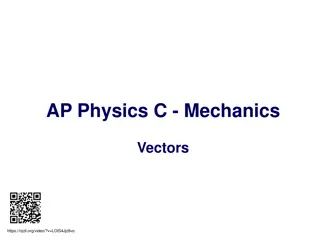Introduction to Cartesian Components of Vectors in Two-Dimensional Space
Exploring Cartesian components of vectors in a two-dimensional coordinate frame using unit vectors i and j. Learn how to express vectors, add them using the triangle law, use column vector notation, and find resultant vectors. Understand position vectors in terms of coordinates. Examples and diagrams aid in visualizing vector operations.
Download Presentation

Please find below an Image/Link to download the presentation.
The content on the website is provided AS IS for your information and personal use only. It may not be sold, licensed, or shared on other websites without obtaining consent from the author.If you encounter any issues during the download, it is possible that the publisher has removed the file from their server.
You are allowed to download the files provided on this website for personal or commercial use, subject to the condition that they are used lawfully. All files are the property of their respective owners.
The content on the website is provided AS IS for your information and personal use only. It may not be sold, licensed, or shared on other websites without obtaining consent from the author.
E N D
Presentation Transcript
CARTESIAN COMPONENTS OF VECTORS
Two-dimensional Coordinate frames The diagram shows a two-dimensional coordinate frame. Any point P in the plane of the figure can be defined in terms of its x and y coordinates.
(All these vectors are multiples of i.) A unit vector pointing in the positive direction of the x- axis is denoted by i. Any vector in the direction of the x-axis will be a multiple of i. A vector of length l in the direction of the x-axis can be written li.
(All these vectors are multiples of j.) A unit vector pointing in the positive direction of the y-axis is denoted by j. Any vector in the direction of the y-axis will be a multiple of j. A vector of length l in the direction of the y-axis can be written lj.
Key Point i represents a unit vector in the direction of the positive x-axis. j represents a unit vector in the direction of the positive y-axis.
Example Draw the vectors 5i and 4j. Use your diagram and the triangle law of addition to add these two vectors together.
Any vector in the xy plane can be expressed in the form r = ai + bj The numbers a and b are called the components of r in the x and y directions.
Example a) Draw an xy plane and show the vectors p = 2i + 3j, and q = 5i + j. Express p and q using column vector notation. Show the sum p + q. Express the resultant p + q in terms of i and j. b) c) d)
Example If a= 9i+ 7jand b= 8i+ 3j, find: a) a+ b b) a b
Key Point The position vector of P with coordinates (a, b) is: r = OP = ai + bj
Example State the position vectors of the points with coordinates: a) P(2, 4) b) Q( 1, 5) c) R( 1, 7) d) S(8, 4)
Example Sketch the position vectors: r = 3i + 4j, r = 2i + 5j, r = 3i 2j. 3 1 2
The modulus of any vector ris equal to its length. As we have noted earlier the modulus of ris usually denoted by |r|. When r= ai+ bjthe modulus can be obtained using Pythagoras theorem. If ris the position vector of point P then the modulus is clearly the distance of P from the origin.
Key Point if r= ai+ bj then |r| = (a + b )
Example Point A has coordinates (3, 5). Point B has coordinates (7, 8). a) Depict these points on a diagram. b) State the position vectors of A and B. c) Find an expression for AB. d) Find |AB|.
This powerpoint was kindly donated to www.worldofteaching.com http://www.worldofteaching.com is home to over a thousand powerpoints submitted by teachers. This is a completely free site and requires no registration. Please visit and I hope it will help in your teaching.




